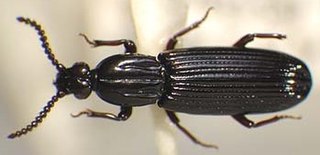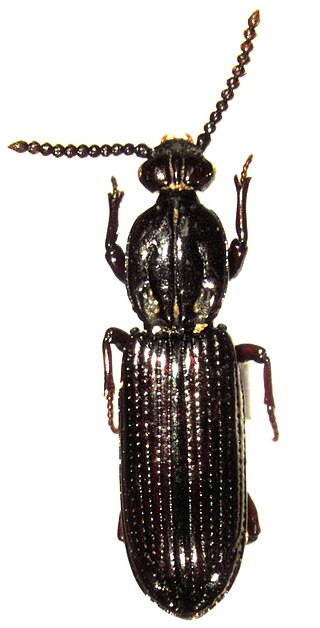Rhysodinae is a subfamily in the family Carabidae. There are 19 genera and at least 380 described species in Rhysodinae. The group of genera making up Rhysodinae had been treated as the family Rhysodidae in the past, and subsequent DNA analysis then placed it within Carabidae, where it was sometimes treated as the tribe Rhysodini, but the most recent analyses place it as a subfamily in a clade along with subfamilies Paussinae and Siagoninae, forming a sister to the remaining Carabidae.

Clinidium is a genus of wrinkled bark beetles in the subfamily Rhysodinae. Most species are Neotropical, but some occur further north in North America and there is also one species in Europe and one in Japan. Two species are known from Miocene amber.

Dhysores is a genus of beetles in the family Carabidae. It is confined to Africa.
Neodhysores is a genus of wrinkled bark beetles in the family Carabidae, found in Southeastern Brazil. Only three specimens of this genus are known to have been found, representing these two species:
Arrowina is a genus of wrinkled bark beetles in the family Carabidae. The genus occurs in Asia, with records from at least Sri Lanka, southern India, Nepal, Thailand, Sumatra (Indonesia), and Japan.

Omoglymmius is a genus in the ground beetle subfamily Rhysodinae. There are more than 150 described species in Omoglymmius, found on every continent except Antarctica.
Plesioglymmius is a genus of wrinkled bark beetles in the family Carabidae. Specimens of this genus are rare.
Shyrodes is a genus of wrinkled bark beetles in the family Carabidae. There are at least two described species in Shyrodes.
Yamatosa is a genus of wrinkled bark beetles in the family Carabidae, found in Asia.

Kaveinga is a genus of wrinkled bark beetles in the family Carabidae.

Kupeus is a genus of wrinkled bark beetles in the family Carabidae. Its only species is Kupeus arcuatus, endemic to New Zealand. K. arcuatus was originally described in 1873 by Louis Chevrolat.
Omoglymmius craticulus is a species of beetle in the subfamily Rhysodidae. It was described by R.T. Bell and J.R. Bell in 1985. It is known from Moroto, southeastern New Guinea.
Omoglymmius cupedoides is a species of beetle in the subfamily Rhysodinae. It was described by R.T. Bell & J.R. Bell in 1993. It is known from Madang, Papua New Guinea, where it was collected in 1896.
Omoglymmius ferrugatus is a species of beetle in the subfamily Rhysodinae. It was described by R.T. Bell & J.R. Bell in 1988. It is known from Potil Kecil in Banggai Archipelago, east of Sulawesi (Indonesia).
Omoglymmius perplexus is a species of beetle in the subfamily Rhysodidae. It was described by R.T. Bell and J.R. Bell in 1985. It is known from Sumatra (Indonesia).
Omoglymmius tolai is a species of beetle in the subfamily Rhysodidae. It was described by R.T. Bell and J.R. Bell in 1985. It is known from New Britain.
Clinidium newtoni is a species of ground beetle in the subfamily Rhysodinae. It was described by Ross T. Bell & J.R. Bell in 1985. It is known from near Pueblo Nuevo Solistahuacán in Chiapas and from Francisco Morazán and Ocotepeque Departments in Honduras. The Honduran specimens were found under bark.
Clinidium segne is a species of ground beetle in the subfamily Rhysodinae. It was described by R.T. Bell & J.R. Bell in 1985. It is known from the Aragua state in northern Venezuela. Clinidium segne females measure 4.6–5.2 mm (0.18–0.20 in) in length.
Rhyzodiastes denticauda is a species of ground beetle in the subfamily Rhysodinae. It was described by R.T. Bell and J.R. Bell in 1985. It is found in Sarawak.

Ross Taylor Bell was an American entomologist with particular interest in the invertebrate natural history of Vermont, United States, and carabid beetles. Together with his wife, Joyce Rockenbach Bell, his work at the University of Vermont was largely taxonomic, where they described more than 75% of the rhysodine species known to science. Ross also wrote a number of seminal papers in his chosen field.






